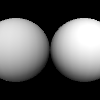light_specular()#
Sets the specular color for lights.
Examples#

def setup():
py5.size(100, 100, py5.P3D)
py5.background(0)
py5.no_stroke()
py5.directional_light(102, 102, 102, 0, 0, -1)
py5.light_specular(204, 204, 204)
py5.directional_light(102, 102, 102, 0, 1, -1)
py5.light_specular(102, 102, 102)
py5.translate(20, 50, 0)
py5.specular(51, 51, 51)
py5.sphere(30)
py5.translate(60, 0, 0)
py5.specular(102, 102, 102)
py5.sphere(30)
Description#
Sets the specular color for lights. Like fill(), it affects only the elements which are created after it in the code. Specular refers to light which bounces off a surface in a preferred direction (rather than bouncing in all directions like a diffuse light) and is used for creating highlights. The specular quality of a light interacts with the specular material qualities set through the specular() and shininess() functions.
Underlying Processing method: lightSpecular
Signatures#
light_specular(
v1: float, # red or hue value (depending on current color mode)
v2: float, # green or saturation value (depending on current color mode)
v3: float, # blue or brightness value (depending on current color mode)
/,
) -> None
Updated on March 06, 2023 02:49:26am UTC
